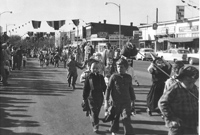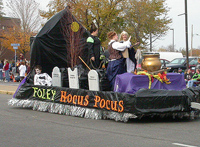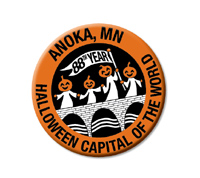|
|
|
Halloween
Capital of the World -
Anoka, Minnesota
 Anoka,
Minnesota is believed to be the first city in the United
States to put on a Halloween celebration to divert its
youngsters from Halloween pranks. When residents of Anoka awoke to find
their cows roaming Main Street, their windows soaped and
their outhouses tipped over, they decided something had to
be done. Anoka,
Minnesota is believed to be the first city in the United
States to put on a Halloween celebration to divert its
youngsters from Halloween pranks. When residents of Anoka awoke to find
their cows roaming Main Street, their windows soaped and
their outhouses tipped over, they decided something had to
be done.
In 1920,
George Green and other Anoka civic leaders suggested the
idea of a giant celebration. The idea was adopted by the
Anoka Commercial Club and the Anoka Kiwanis Club; both
giving their full support. In September of that year, a
Halloween committee was organized. Working hand in hand were
businessmen, teachers from the Anoka public and parochial
schools, parents, and students. For weeks before the big
event, more than a thousand Anoka school children made plans
and costumes for the big event.
 A
parade was scheduled for the evening. Participants included
local and neighboring bands, drum corps, the Anoka police
and fire departments, the Kiwanis club, the Commercial Club,
and the Anoka National Guard; all working together to make
the evening a success. A
parade was scheduled for the evening. Participants included
local and neighboring bands, drum corps, the Anoka police
and fire departments, the Kiwanis club, the Commercial Club,
and the Anoka National Guard; all working together to make
the evening a success.
Hundreds of bags of
popcorn, candy, peanuts and other treats were given away to
the children who marched in the parade. By the 1930s, the festivities
had expanded as had the attendance at the parades. There
were over 2,000 costumed children marching down Main Street.
It was estimated that 20,000 spectators lined the streets to
watch this night-time spectacle.
In 1937, 12-year-old,
Harold Blair, donning a sweater embellished with a Halloween
Capital insignia, carried with him to Washington, D.C. a
proclamation naming Anoka the Halloween Capital of the
World.
 Anoka
has always worked to keep a family spirit alive in its
Halloween festivities. Activities have included pillow
fights, a kangaroo court, fireworks displays, royalty
coronations, concerts, dances, window painting contests,
house decorating contests, celebrity appearances, costume
contests, style shows, story-telling, races and, in the
1960s, a snake dance that took long lines of participants in
and out of area businesses and homes. Anoka
has always worked to keep a family spirit alive in its
Halloween festivities. Activities have included pillow
fights, a kangaroo court, fireworks displays, royalty
coronations, concerts, dances, window painting contests,
house decorating contests, celebrity appearances, costume
contests, style shows, story-telling, races and, in the
1960s, a snake dance that took long lines of participants in
and out of area businesses and homes.
Anoka's Halloween celebration
continues to be world class. Participation in the night
parade and Grand Day parade has grown to include units from
all over the mid-west. The original concept of having
costumed students parade down Main Street continues on as
well on the Friday preceding the Grand Day parade. Anoka
residents can watch their grandchildren or great
grandchildren continue the tradition they started so many
years ago.
Click here for official information.
"How Anoka, Minnesota Became the Halloween
Capital of World"
by Sharron Stockhausen
 Halloween came to America in the 1840s with Scottish and
lrish immigrants. Although clergy frowned on its celebration, Americans found upbeat ways
to celebrate the "dark" holiday and by the1870s fancy costume parties were found
everywhere. Halloween came to America in the 1840s with Scottish and
lrish immigrants. Although clergy frowned on its celebration, Americans found upbeat ways
to celebrate the "dark" holiday and by the1870s fancy costume parties were found
everywhere.
As the holiday headed west, Halloween celebrants put wagons on roofs, stole gates, let
cattle loose, and turned over outhouses whether they were occupied or not.
In 1920, Anoka businessman and civic leader George Green suggested an organized
celebration to keep the young folks busy.
The Anoka Commercial and Kiwanis clubs gave him their full support and in September a
committee was formed. Soon teachers. parents and students joined in. Anoka became the
self-declared Halloween Capital of the World.
For the next month 1,000 Anoka students dreamed of their costumes. An evening parade
featuring local and neighboring bands and drum corps was planned. After the parade,
hundreds of bags of popcorn, candy, and peanuts were passed out to the marching costumed
children. Everyone gathered at Bridge Square for a large bonfire and program.
Every year the celebration grew more popular, but in 1942 and 1943 it was canceled because
of World War II.
By 1947 the number of marching children had almost tripled, so the parade was moved to 2
p.m. and all the children kindergarten though grade three from Anoka and neighboring towns
such as Champlin, St. Francis, and Coon Rapids were included.
When I was in grade school, all students were judged at their own schools in the various
costume categories. Then everyone was bussed to Franklin School to prepare for the
afternoon march down Main Street. We got treats at the end of the parade.
Later that evening the parade of floats, bands, and other participants marched toward the
Pumpkin Bowl football game where Anoka played someone we hoped it could beat. During half
time the parade arrived and we cheered as it circled in front of the football fans.
There have been many changes since the celebration began. This is the third year for
hearing our stories at Colonial Hall. I hope to see - you tonight or tomorrow.
Article from the Anoka County Shopper of Anoka, Minnesota Published October 28th, 1998.
|
|